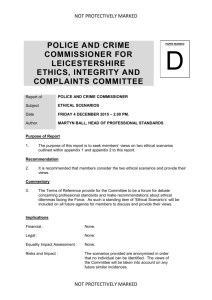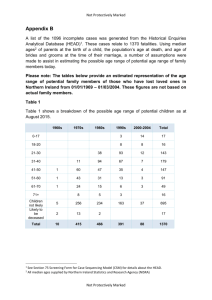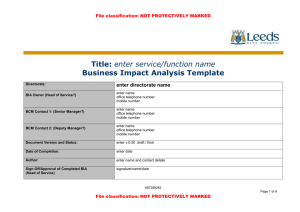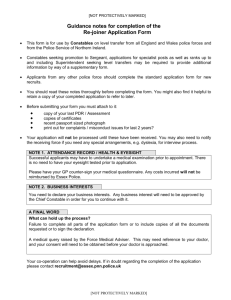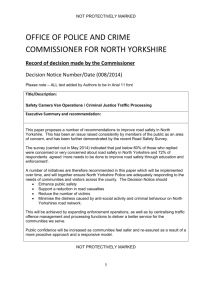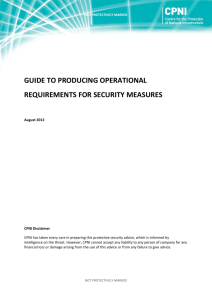BCH10_001 Joint Scientific Services Policy
advertisement
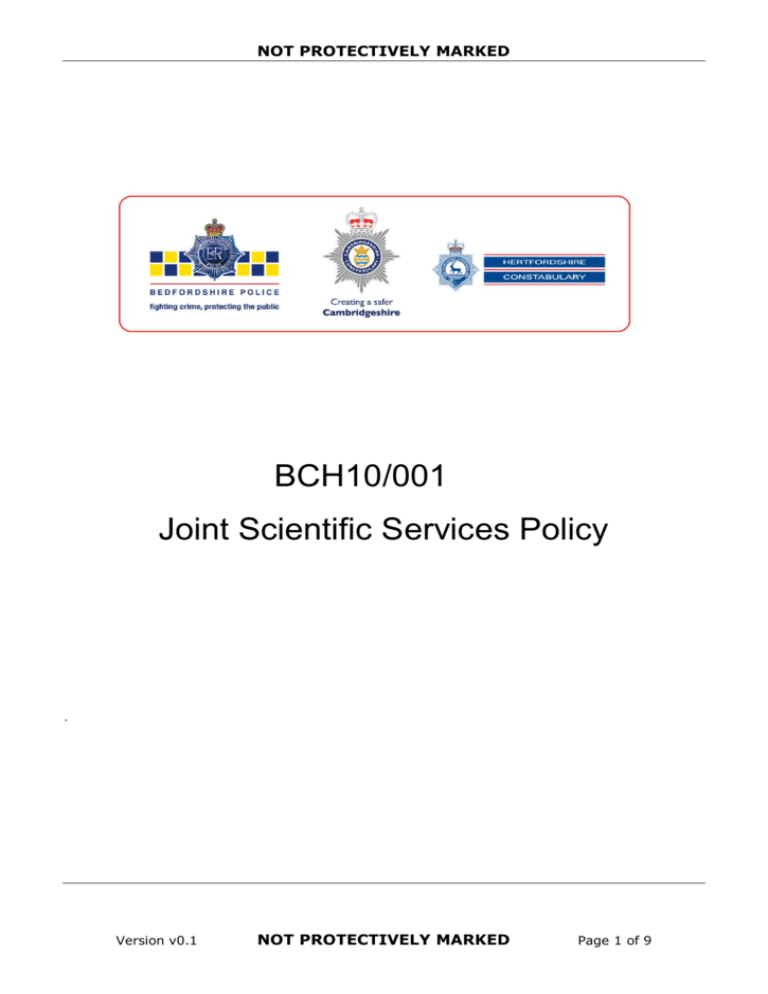
NOT PROTECTIVELY MARKED BCH10/001 Joint Scientific Services Policy . Version v0.1 NOT PROTECTIVELY MARKED Page 1 of 9 NOT PROTECTIVELY MARKED TABLE OF CONTENTS 1. POLICY AIM ................................................................................................. 3 2. APPLICABILITY ............................................................................................. 3 2.1 Inclusions ........................................................................................... 3 2.2 Exclusions ........................................................................................... 3 3. POLICY DETAIL ............................................................................................ 3 4. TRAINING AND ACCREDITATION REQUIREMENTS ............................................ 4 5. ASSOCIATED DOCUMENTATION ..................................................................... 4 5.1 Legislation/ National Guidance ............................................................... 4 5.2 Strategy/ Plan ..................................................................................... 4 5.3 Policies ............................................................................................... 4 5.4 Procedures .......................................................................................... 5 5.5 Forms (National/ Local) ........................................................................ 5 6. WHO TO CONTACT ABOUT THIS PROCEDURE ................................................... 5 7. EQUALITY ANALYSIS ..................................................................................... 5 Version v0.1 NOT PROTECTIVELY MARKED Page 2 of 9 NOT PROTECTIVELY MARKED 1. POLICY AIM 1.1. The Bedfordshire, Cambridgeshire and Hertfordshire (BCH) Scientific Services policy and procedures establishes an expected organisational approach to the use of Forensics which will lead to a consistent approach to quality, training, deployment and decision making in the forensic field. 2. APPLICABILITY 2.1 Inclusions 2.1.1 The application of the Bedfordshire, Cambridgeshire and Hertfordshire Scientific Services Unit policy and procedures applies to all staff including the extended police family and those working voluntarily or under contract. They must be aware of and are required to comply with the policy and procedures contained therein. Responsibilities 2.1.2 The Bedfordshire Police, Cambridgeshire and Hertfordshire Constabularies Assistant Chief Constables (Protective Services) are the nominated ACPO leads in relation to the use of Scientific Services. 2.1.3 The Head of Scientific Services for formulation, implementation, delivery and review of the scientific services strategy and supporting strategies in order to provide an effective and efficient service across all three BCH counties. 2.2 Exclusions 2.2.1 This procedure does not apply to anyone who is not employed by Bedfordshire, Cambridgeshire or Hertfordshire Police forces. 3. POLICY DETAIL 3.1. It is the policy of Bedfordshire Police, Cambridgeshire and Hertfordshire Constabularies to provide Police Scientific Services capability to assist in the prevention, reduction and detection of criminality within the three counties and if required through mutual aid, to the rest of the United Kingdom. These duties include scene/property examination, provision of forensic imagery and identification of persons by means of fingerprints and other identification mediums. In delivering a dynamic forensic capability across Bedfordshire, Cambridgeshire and Hertfordshire we aim to fully support the people of 3 counties, engendering their trust and confidence in the service provided. Version v0.1 NOT PROTECTIVELY MARKED Page 3 of 9 NOT PROTECTIVELY MARKED Definitions CSC - Crime Scene Coordinator CSM - Crime scene Manager CJ - Criminal Justice DNA - Deoxyribonucleic acid R2S - Return to Scene ACPO - Association of Chief Police Officers 4. TRAINING AND ACCREDITATION REQUIREMENTS EU Framework Direction 2009/905/JHA stipulate that all fingerprint development laboratories must be accredited to ISO 17025:2005. 5. ASSOCIATED DOCUMENTATION 5.1 Legislation/ National Guidance Police and Criminal Evidence Act 1984 BS EN ISO 9001:2008 Quality Management Systems – Requirements BS EN ISO 17025:2005 Competence of testing and calibration laboratories – Requirements National Fingerprint Manual National Crime Scene Investigation Manual National Scientific Support Laboratories Manual 5.2 Strategy/ Plan 5.2.1 Not applicable 5.3 Policies 5.3.1 Not applicable Version v0.1 NOT PROTECTIVELY MARKED Page 4 of 9 NOT PROTECTIVELY MARKED 5.4 Procedures BH010/002 Capture Preservation of Evidential Images from Digital Still and Video Recordings BCH10/003 Safe Recovery of Firearms and Ballistic Material Policy and Procedure O019 Forensic Solutions for persons in custody Policy and Procedure (Bedfordshire Police Only) O020 Forensic Solution Activation at Incident Scene Policy and Procedure (Bedfordshire Police Only) Service Level Agreement between SSU Laboratory and Hertfordshire and Bedfordshire Customers 5.5 Forms (National/ Local) 5.5.1 Not applicable 6. WHO TO CONTACT ABOUT THIS PROCEDURE 6.1 Questions regarding this procedure and its operation should initially be referred to the Head of Scientific Services. 7. EQUALITY ANALYSIS EQUALITY IMPACT ASSESSMENT Name of Sponsor Name of Author Head of Scientific Services Description of proposal being analysed Date EIA started October 2012 Date EIA finished This Equality Impact Assessment is being undertaken as a result of a new or updated policy or procedure. Version v0.1 NOT PROTECTIVELY MARKED Page 5 of 9 NOT PROTECTIVELY MARKED STEP 1 – Relevance The general duty is set out in section 149 of the Equality Act 2010. In summary, those subject to the Equality Duty must have DUE REGARD to the need to: eliminate unlawful discrimination, harassment and victimisation; advance equality of opportunity between different groups; and foster good relations between different groups. Authors have a statutory requirement to have DUE REGARD to the relevant protected characteristics shown below, whilst taking a common sense approach age disability gender reassignment marriage & civil partnership* pregnancy and maternity race religion or belief sex sexual orientation *marriage and civil partnership – the analysis applies only to the elimination of unlawful discrimination, harassment and victimisation. Section 23 of the Equality Act 2006 allows the Equality and Human Rights Commission (EHRC) to enter into a formal agreement with an organisation if it believes the organisation has committed an unlawful act. Under section 31 of the Equality Act 2006, the EHRC can carry out a formal assessment to establish to what extent, or the manner, in which a public authority has compiled with the duty. Additional guidance can be found by accessing the EHRC website: http://www.equalityhumanrights.com/advice-and-guidance/public-sector-equality-duty/guidance-on-the-equalityduty/ Does this proposal have a direct impact on people who: If NO to both questions a) are any part of the Police workforce (including volunteers)? b) reside in any part of England and Wales YES YES Explain why and give rational No Further Action and Return to Sponsor for Authorisation If Yes to either question Continue through to Step 2 STEP 2 – Consultation / Engagement You should engage with those people who have an interest in how you carry out your work generally, or in a particular proposal. This may include former, current and potential service users, staff, staff equality groups, Version v0.1 NOT PROTECTIVELY MARKED Page 6 of 9 NOT PROTECTIVELY MARKED trade unions, equality organisations and the wider community. In deciding who to engage, you should consider the nature of the proposal and the groups who are most likely to be affected by it. The proposal owner (Sponsor/Author) must be satisfied that consultation / engagement will take place with the relevant business lead and stakeholders. This MUST include engagement with the following relevant groups: Equality and Diversity Specialist Staff Associations Staff Support Groups Relevant community groups and members of the public In addition, consider who else should you consult with internally and externally? Who might be affected? Does what you are considering further the aims of the general duty, to eliminate unlawful discrimination, harassment and victimisation; advance equality of opportunity between different groups; and foster good relations between different groups. Identify the risks and benefits where applicable, according to the different characteristics. Positive Impact or Benefits Negative Impact or Risks Age (Consider elderly or young It is not anticipated that there people) will be a differential or adverse impact due to the age of the individual Disability Groups (Consider physical, sensory, cognitive, mental health issues or learning difficulties) Gender Reassignment (Consider transgender, Transsexual, Intersex) Marriage & Civil Partnership Pregnancy and Maternity Race and Ethnic origin – includes gypsies and travellers.(Consider language and cultural factors) Religious / Faith groups or Philosophical belief (Consider Version v0.1 NOT PROTECTIVELY MARKED Page 7 of 9 NOT PROTECTIVELY MARKED practices of worship, religious or cultural observance including non belief) Sex (Male, Female) Sexual orientation (Consider known or perceived orientation, lesbian, gay or bisexual) Positive Impact or Benefits Have you considered how this Negative Impact or Risks No perceived impact decision might affect work life balance? (Consider caring issues re: childcare & disability, safeguarding issues, environmental issues, socio economic disadvantage, and low income families.) STEP 3 – Assessment Complete the EIA by analysing the effect of your proposal and detail the outcomes. What were the main findings from any consultation carried out? What feedback has been received? Using the information you have gathered and consultation that you have undertaken answer the following questions. This will help you to understand the effect on equality your proposal might have. Has the feedback indicated any problems that need to be addressed? Describe and evidence any part of the proposal which could discriminate Can the adverse impact identified be justified as being appropriate and necessary? If so, state what the business case is: Where impact and feedback identified, what, if anything can be done? What outcome will be achieved that demonstrates a positive impact on people? STEP 4 - Monitoring and Review Version v0.1 NOT PROTECTIVELY MARKED Page 8 of 9 NOT PROTECTIVELY MARKED Equality analysis is an ongoing process that does not end once a document has been produced. What monitoring mechanisms do you have in place to assess the actual impact of your proposal? Review Date: First review must be no later than one year. STEP 5 - Sign Off Once the Equality Impact Assessment is complete it should be signed off by the Proposal Sponsor. This sign off is confirmation that the analysis is accurate, proportionate and relevant and actions will be delivered as required. Approved by Senior Officer / Proposal lead Having considered the potential or actual effect of this proposal on equality, our assessment demonstrates that the proposal is robust and the evidence of our screening shows no potential for unlawful discrimination. We have taken all appropriate opportunities to advance equality and foster good relations between groups. Date: October 2012 Name: Steve Healy, Head of Forensic Intelligence Version v0.1 NOT PROTECTIVELY MARKED Page 9 of 9
